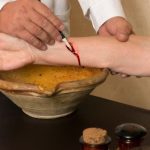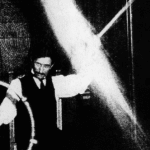 History
History  History
History  Weird Stuff
Weird Stuff 10 Superstitious Beliefs That Once Consumed Entire Cultures
 History
History 10 Bizarre Friendly Fire Incidents in Military History
 Technology
Technology 10 Modern Technologies That Accidentally Imitate Ancient Magic
 Mysteries
Mysteries 10 Mysteries of the Human Genome
 Weird Stuff
Weird Stuff 10 Things So Rare They’ve Only Been Found Once
 History
History 10 Legends Whose Last Moments Undid Their Glory
 Health
Health 10 Futuristic Ideas to Treat Common Medical Problems
 Weird Stuff
Weird Stuff Ten Surreal Attempts to Reverse Baldness
 Facts
Facts 10 U.S. Government Contingency Plans for the Unthinkable
 History
History 10 Odd Things Colonial Americans Kept at Home
 Weird Stuff
Weird Stuff 10 Superstitious Beliefs That Once Consumed Entire Cultures
 History
History 10 Bizarre Friendly Fire Incidents in Military History
Who's Behind Listverse?

Jamie Frater
Head Editor
Jamie founded Listverse due to an insatiable desire to share fascinating, obscure, and bizarre facts. He has been a guest speaker on numerous national radio and television stations and is a five time published author.
More About Us Technology
Technology 10 Modern Technologies That Accidentally Imitate Ancient Magic
 Mysteries
Mysteries 10 Mysteries of the Human Genome
 Weird Stuff
Weird Stuff 10 Things So Rare They’ve Only Been Found Once
 History
History 10 Legends Whose Last Moments Undid Their Glory
 Health
Health 10 Futuristic Ideas to Treat Common Medical Problems
 Weird Stuff
Weird Stuff Ten Surreal Attempts to Reverse Baldness
 Facts
Facts 10 U.S. Government Contingency Plans for the Unthinkable
Top 10 Strangest Things Done with Hearts Throughout History
Hearts can be seen everywhere when Valentine’s Day rolls around—from romantic cards adorned with hearts to heart-shaped chocolates and candies filling stores. But throughout history, humans have also done some strange (and less saccharine!) things with actual hearts, such as in the organ, not the symbol.
Below, you’ll find a few morbidly fascinating funerary practices, some strange surgeries, and a handful of biological oddities.
Related: 10 Amazing Facts about Heartbeats That You Will Hardly Believe
10 The Hearts of 22 Popes Are Kept in a Roman Church
The Trevi Fountain is one of the most popular tourist destinations in Rome, but many of the people tossing coins into the water are unaware that just steps away is a church with a collection of pope hearts. Santi Vincenzo e Anastasio a Trevi is currently home to 22 marble urns that contain papal hearts—from Sixtus V, who died in 1583, to Leo XIII, who joined him in 1903.
The practice was borrowed from Byzantine emperors, whose inner organs were removed after death. Back when the tradition started, a deceased pope’s body would be mourned for 9 days before burial, so embalming everything was key to ensuring that rot didn’t set in. Their hearts were saved so that their religious followers would have a relic to venerate.
When Pope Pius X died in 1914, his will forbade the removal of his organs, and every pope since then has agreed that they’d rather be buried whole. Although the practice has ceased, those wishing to view or pray to the previously extracted hearts are free to do so.[1]
9 Mary Shelley Kept Her Husband’s Heart
In 1822, 29-year-old poet Percy Bysshe Shelley, husband of Frankenstein author Mary Shelley, drowned in a storm off the coast of Italy while out sailing. When his body washed ashore days later, his remains were cremated on the beach, but the story goes that his heart wouldn’t burn. His friend Leigh Hunt took the heart for himself but eventually handed it over to Mary. When she then died in 1851, the heart was found wrapped in silk in her desk, alongside an elegy Percy had written for poet John Keats.
There are a few theories that might explain the odd occurrence of Percy’s heart not burning. Biographer Edward John Trelawny stated that “in all cases of death from suffocation, the heart is gorged with blood; consequently, it is the more difficult to consume, especially in the open air.” Others put it down to “calcification, possibly from an earlier tubercular infection.”
And then there’s the theory that it wasn’t even his heart that survived, but instead, his liver, which was saturated with seawater and therefore more resistant than usual to the flames. Whatever the story, the fact that Mary kept a part of her husband is fittingly macabre for the author of such an iconic horror novel.[2]
8 Mesoamerican Ceremonial Heart Sacrifice
The idea of sacrificing humans by cutting out their hearts isn’t just limited to the scary scene at the end of Indiana Jones and the Temple of Doom (1984); the practice was actually fairly common amongst Mesoamerican tribes. Although physical remains from ancient cultures are often scarce, researchers have found evidence of human sacrifice, which was usually conducted to appease the gods and stave off famine, drought, and disease.
Skeletal remains show evidence of heart extraction, with anthropologist Vera Tiesler noting that creating a “slit below the rib cage with the victim lying on its back in an overextended position was the most common method because it is the easiest access and it does not require to cut through bony tissue.” The gory ceremony is also depicted in Mesoamerican art and in writings by Spanish colonizers. “[Heart sacrifice] may appear to be gratuitous violence now, just like Medieval and Renaissance Europe with its heresy trials, its holy office, and massive religiously motivated killings,” says Tiesler, “but was held to be worthy and effective at the time it was practiced.”[3]
7 Frédéric Chopin’s Heart Is Pickled in Alcohol
Most of renowned composer Frédéric Chopin’s body is buried in Père Lachaise Cemetery in Paris, but his heart rests in the Basilica of the Holy Cross in Warsaw. Chopin had a fear of being buried alive, so he requested that an autopsy be performed on his body when he died—which happened in 1849. However, he asked his sister, Ludwika Jędrzejewicz, to take his heart back to his homeland of Poland upon his death.
To preserve the heart for its journey, it was submerged in a jar of alcohol (thought to be cognac). Around a century later, in 1944, the heart was removed from the church and found a new home at the headquarters of SS commander Erich von dem Bach-Zelewski. After World War II, the heart was returned and interred in a pillar, where it rests to this day.
In 2014, the heart was secretly exhumed. Questions have long surrounded the cause of Chopin’s death, and it was hoped that visually examining the heart—they didn’t dare open the jar—would reveal the answer. The researchers described his heart as “massively enlarged and floppy” and covered in a white substance, which gave it a “frosted” look. They decided that pericarditis—essentially inflammation around the heart brought on by tuberculosis—was likely the killer, but it’s far from conclusive.[4]
6 Pig-to-Human Heart Transplants
People in need of organ transplants can sometimes be left on waiting lists for years. However, recently, scientists have thought up a possible solution to cut down on waiting time: using genetically modified animal organs. Known as xenotransplantation, animal-to-human transplants are still incredibly experimental.
In 2022, David Bennett became the first person to receive a pig heart that had been altered to remove the gene responsible for the continued growth of the organ. Lawrence Faucette became the second person in 2023. Both men—suffering from heart failure and heart disease, respectively—were too sick to receive traditional transplants, hence why they opted for an experimental surgery. Unfortunately, Bennett died two months after his surgery, while Faucette died six weeks after his, but scientists are still optimistic.
Pigs aren’t the only animals to have had their innards pilfered. Back in 1984, a baby with heart disease—called Stephanie Fae Beauclair, but known as Baby Fae—received a baboon heart transplant but sadly died 21 days later. While some thought that the surgery was revolutionary, others considered it to be “ghoulish tinkering.”[5]
5 Reanimated Baboon Heart Transplants

On the subject of baboon hearts, scientists have also transplanted reanimated hearts into baboons, with a view to eventually applying this to humans. Five test subject baboons received dead and then reanimated baboon hearts. However, all the primates ended up dying (within a range of 1 to 34 days). Three of the baboons died due to organ rejection, one had a stroke, and another died of diarrhea/dehydration.
Although those results may seem poor, the scientists concluded—based on the baboons showing no fibrosis or issues with blood flow—that organ reanimation was possible and that “human application is realistic and could greatly expand the donor pool.” However, given that the research paper was published back in 1995 and there’s been no word on progress, this surgery might never be widely available.[6]
4 Thomas Hardy’s Heart Was Allegedly Eaten by a Cat
When writer Thomas Hardy died in 1928, there was debate over where he should be buried. Hardy had said that he wanted to be buried alongside his family in Stinsford, Dorset, but there was a push—led by Hardy’s literary executor, Sydney Cockerell—to lay him to rest in Westminster Abbey’s Poets Corner. A compromise was struck: Hardy’s heart would be removed and buried at Stinsford, while the rest of his remains would be buried at Westminster.
Although there’s no proof of this, some say that when the doctor removed Hardy’s heart, he was called away, and when he returned, he discovered that a cat had eaten the organ. Some versions of the story say that the cat was killed and interred in the urn. Others say that the doctor hurried down to the butcher and bought a pig’s heart as a substitute. The truth of the matter will likely never be known, but it is certainly a good story fitting of a great writer.[7]
3 Robert the Bruce’s Heart Was Taken Into Battle
When King of Scots Robert the Bruce died in 1329, it was common practice to bury a monarch’s organs and body separately. Robert had asked for his heart to be taken to the Holy Land before being buried, so the organ was put into a silver urn and given to Sir James Douglas to wear around his neck. However, Douglas was then called to fight for King Alfonso XI of Spain against invaders from Granada. Douglas was killed in the battle, but legend has it that before dying, he hurled the dead king’s heart ahead of him and yelled, “Lead on, brave heart, I’ll follow thee.”
Although Robert the Bruce’s heart never made it to the Holy Land, it did at least make it back to Scotland with Douglas’s remains. The heart was buried at Melrose Abbey. The Scots poem, penned by John Barbour, on the grave marker translates to, “A noble heart can know no ease without freedom.”[8]
2 William Buckland Ate a Mummified Human Heart
William Buckland, born in 1784, was the Dean of Westminster and a geologist who is credited with giving the first description of a dinosaur fossil. But he also had a rather eccentric hobby: eating any animal he could get his hands on—a practice known as zoophagy. Why exactly he wanted to eat his way through the animal kingdom isn’t known. Still, his observations on his odd meals were documented. According to his taste buds, moles and bluebottle flies tasted the worst.
Buckland was also a cannibal—although perhaps unintentionally. His friend Lord Harcourt had come into the possession of the mummified heart of King Louis XIV of France. When he showed it to Buckland, the geologist put the dried-up remains into his mouth and swallowed. It’s been suggested that he may have thought the object was a stone and didn’t mean to swallow it. Still, given his already strange eating habits, it’s not a stretch of the imagination to assume that he knew what he was doing. Allegedly, after swallowing the heart, he said, “I have eaten many strange things but have never eaten the heart of a king before.”[9]
1 Hugh Montgomery’s Heart Could Be Seen Through a Hole in His Chest
Back in the mid-1600s, a young Irish nobleman called Hugh Montgomery fell off of his horse onto a fence, stabbing a hole into his chest. Although Montgomery recovered, the hole never healed, so his father created a metal plate to cover the opening. For a period, Montgomery toured Europe to show off his inner workings to anyone who was curious enough to pay for a ticket. At the time, it was thought that the organ on show was a lung.
Word of Montgomery’s medical curiosity eventually fell upon the ears of famed physician William Harvey. Upon inspecting the gaping hole—”into which I could easily put my three Fore-fingers and my thumb,” Harvey noted—he realized that the organ was actually Montgomery’s heart. (LINK 19) Harvey then took the young nobleman to King Charles I because even royals aren’t above marveling at a beating heart in situ.[10]








